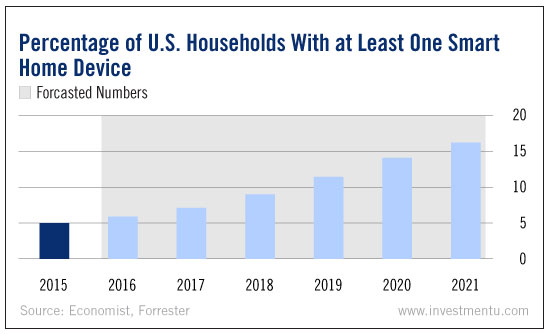On Tuesday, I explained why I think artificial intelligence will be among the top technology trends of 2017. Today I’ll focus on another trend that should see big gains over the coming year.
I’ve written about the Internet of Things (IoT) here before. The idea is to connect everyday objects to the internet, granting them all sorts of new features and applications (i.e., making them 'smart').
There’s a rush right now to make as many household items as possible part of the IoT, even if there’s seemingly no need.
There are smart water bottles, smart forks, smart toothbrushes and even smart tampons. (Yes, that's a real thing. And though the idea behind it is meant to be helpful, I haven’t met any women excited by the prospect.)
Connecting all of these objects to the internet may seem like overkill. But the reality is that it’s not enough. At least not for what we want to accomplish.
It’s fitting that I wrote about artificial intelligence earlier this week. The other part of AI -- the piece necessary to make it work for us on a personal and industrial level -- is the continued expansion of the IoT.
You already have a smartphone. Maybe even a smartwatch. Many of us even have smart TVs in our home. And don’t worry; if you don’t already, you will soon.
Consumers are on track to spend $114 billion upgrading to smart TVs this year. It’s all happening as the cost of these and other IoT devices quickly declines.
As prices come down, the prevalence of IoT products in American homes is expected to go up.
Smart Butler
And just like with AI, there are some major figures behind the push for adoption.
In a post Monday, Facebook (NASDAQ:FB) CEO Mark Zuckerberg highlighted how much the IoT market must grow.
Zuckerberg has spent the past year creating a digital butler named “Jarvis.” His post detailed his progress so far and revealed some surprising tidbits about the process.
Zuckerberg noted that achieving his goal to run a mile per day in 2016 took more time than programing Jarvis to control various aspects of his home. But one of the project’s biggest limitations, he said, was the lack of IoT appliances.
Jarvis can control lighting. It can control the thermostat. It can play music. Plus, it can manage Zuckerberg’s home security system.
But Jarvis couldn’t make him toast or a cup of coffee.
Now, that might seem like a silly complaint. But when you’re running an experiment to create a digital butler and these are some of your biggest obstacles, it just shows how far we still need to go.
There are countless objects that have yet to be added to the IoT. As it stands, the entire smart home market -- smart thermostats, smart smoke and CO2 detectors, smart security cameras, smart locks, etc. -- will reach $1.3 billion this year. An estimated 9.5 million of these devices will be sold.
Tip Of The Iceberg
Over the next four years, 34 billion devices are expected to be connected to the internet. That’s up from 10 billion in 2015. That’s a projected increase of 240% by 2020. And we’re not just talking about smartphones and tablets.
Of those 34 billion connected devices, traditional tech gadgets will account for just 10 billion. The rest will be emerging IoT technologies.
From a 2014 value of $655.8 billion, the global IoT market is expected to reach $1.7 trillion by 2020.
By 2025, the IoT market has the potential to generate between $3.9 trillion and $11.1 trillion in economic value. That means it could make up roughly 11% of the world’s economy.
So, clearly the forecasts are bullish. But the funny thing is that there’s actually a debate that many of the projections here are underestimated.
Factories are one area that’s often overlooked when discussing the IoT. It will likely be the largest contributor of growth, generating anywhere between $1.2 trillion and $3.7 trillion annually.
Driving toward these seemingly unbelievable numbers, in 2017, IoT platform revenue is expected to increase 116%. This will be led by industrial, automotive, smart home, smart cities and retail.
Another exciting IoT application? Something I also wrote about this year: turning data into food. Here’s a short excerpt from that article:
Monsanto (NYSE:MON) is using IoT with its FieldDrive platform. This pulls yield, soil quality, moisture and positioning data from sensors on combines and tractors. That’s added to weather forecasts and other data points. And all of it is fed via satellite back to Monsanto’s “big data” center.Growers use this information to make decisions on soil topology and combine routes. The result: improved harvest quality.
This isn’t about convenience, but about something we need.
As naturalist Joseph Krutch said, “Technology made large populations possible; large populations now make technology indispensable.”
From A.D. 1 to 1800, the world’s population grew from 300 million to 1 billion. But as technology improved, we multiplied even faster. From 1950 to 2005, the world’s population increased from 2.5 billion to 6.5 billion. It was the most rapid expansion the world has ever seen.
Looking toward the future, the human population will continue to grow and grow. The IoT will help us feed that population.I realize I may be starting to sound like a broken record here, but it all comes back to my three C’s for technology investing. (Once again, that’s Connectivity, Content and Community.)
The IoT is all about a connected world. It brings together the tools and devices we already use each day. This market isn’t the newest, most exciting segment of the tech sector. But the changes here are mandatory.
That’s what makes the size of this opportunity so staggering. The IoT won’t just be big in 2017. It will continue to expand for years to come.
Good investing.

